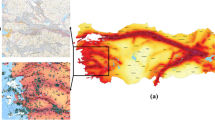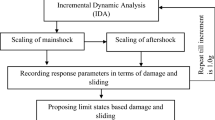Abstract
Failure of one-story precast structures consisting of cantilever columns connected by simply supported beams was widely reported throughout the epicentral regions of the last devastating earthquakes in Turkey. As a single degree of freedom system, precast columns are designed by using the elastic spectrum given in the seismic code and by considering a seismic load reduction factor which takes into account the inelastic behavior of the columns under seismic loads. Although the existing seismic codes consider near-fault shaking effects in the development of elastic response spectra, they do not currently consider the increased inelastic demands that may occur during near-fault ground motion. The current study consists of nonlinear time history analyses of various hypothetical columns having geometric and mass properties which are being used in Turkish precast industry and the evaluation of damage indexes (DI) in terms of peak ground velocity (PGV) and peak ground acceleration (PGA) of the used strong ground motions. It is achieved that near-fault earthquakes create more damages on the columns. This might be one of the main reasons for the collapse of several one-storey precast buildings which were well designed according to the seismic codes in the district of existing faults. The obtained PGV versus DI charts prove that if one increase the sectional dimensions and/or longitudinal reinforcement ratio of the column, the possible damage from near-fault shaking effects could be reduced.
Similar content being viewed by others
References
Akkar S, Sucuoglu H (2003) Peak Ground Velocity Sensitive Deformation Demands and a Rapid Damage Assessment Approach. In: Wasti T, Ozcebe G (eds) Seismic assessment and rehabilitation of existing buildings. NATO science series: IV. Earth and environmental sciences, vol 29. Kluwer Academic Publishers, London, pp 77–96
Akkar S, Ozen O (2005) Effect of peak ground velocity on deformation demands for SDOF systems. Earthq Eng Struct Dyn 34: 1551–1571
Ambraseys N, Smit P, Sigbjornsson R, Suhadolc P, Margaris B (2002) Internet-site for European strong-motion data. European commission. Research-directorate general, Environment and climate programme
ATC (1997) Seismic evaluation and retrofit of concrete buildings, ATC-40, Applied Technology Council, Redwood City, California
Ataköy H (1999) 17 August Marmara earthquake and the precast structures built by TPCA members. Turkish Precast Concrete Association, Ankara, Turkey
Bruneau M (2002) Building damage from the Marmara, Turkey earthquake of August 17, 1999. J Seismo 6(3): 357–377
COSMOS Virtual Data Center (2006) Consortium of organizations for strong motion observation systems (COSMOS). University of California. http://db.cosmos-eq.org/scripts/default.plx
FEMA (1997) NEHRP guidelines for the seismic rehabilitation of buildings. FEMA273, Federal Emergency Management Agency, Washington
FEMA (1998) NEHRP recommended provisions for seismic regulations for new buildings and other structures. FEMA302, Federal Emergency Management Agency, 1997 Ed., Washington
Karadogan F, Yuksel E, Yuce S, Taskın K, Saruhan H (2006) Experimental study on the original and retrofitted precast columns. Technical report (in Turkish), Istanbul Technical University
Kunnath SK, Reinhorn AM, Lobo RF (1992) IDARC version 3.0: a program for the inelastic damage analysis of RC structures. Technical report. NCEER-92-0022, National Center for Earthquake Engineering Research, State University of New York, Buffalo
Macrea GA, Morrow DV, Roeder CW (2001) Near-fault ground motion effects on simple structures. J Struct Eng ASCE 127(9): 996–1004
Park YJ, Ang AH (1985) Mechanistic seismic damage model for reinforced concrete. J Struct Eng ASCE 111(4): 722–739
Park YJ, Ang AH, Wen YK (1985) Seismic damage analysis of reinforced concrete buildings. J Struct Eng ASCE 111(4): 740–757
Park YJ, Reinhorn AM, Kunnath SK (1987a) IDARC: inelastic damage analysis of reinforced concrete frame–Shear-Wall Structures. Technical report NCEER-87-0008, State University of New York, Buffalo
Park YJ, Reinhorn AM, Wen YK (1987) Damage-limiting aseismic design of buildings. Earthquake Spectra 3(1): 1–26
PEER Strong Motion Database (2000) Pacific earthquake engineering research center. California. http://peer.berkeley.edu/smcat
Reinhorn AM, Kunnath SK, Valles RE (2006) IDARC2D V6.1, A Program for the inelastic damage analysis of buildings. State University of New York at Buffalo
Saatcioglu M, Mitchell D, Tinawi R, Gardner NJ, Gillies AG, Ghobarah A et al (2001) The August 17, 1999, Kocaeli (Turkey) earthquake—damage to structures. Can J Civ Eng 28: 715–737
SAC Steel Project (1997) Impulsive near-field earthquake ground motions. Richmond. http://www.sacsteel.org
Seismosignal v.3.2 (2006) SeismoSoft. http://www.seismosoft.com
Sezen H, Elwood KJ, Whitaker AS, Mosalam KM, Wallace JW, Stanton JF (2000) Structural engineering reconnaissance of the August 17, 1999, Kocaeli (Izmit), Turkey. Earthquake Rep No 2000/09. Pacific Engineering Research Center. University of California, Berkeley
Sezen H, Whittaker AS (2006) Seismic performance of industrial facilities affected by the 1999 Turkey earthquake. J Per Const Fac ASCE 20(1): 28–36
Shuang L, Li-li X (2006) Progress and trend on near–field problems in civil engineering. Acta Seismologica Sinica 20(1): 105–114
Sivaselvan MV, Reinhorn AM (2000) Hysteretic models for deteriorating inelastic structures. J Eng Mech ASCE 126(6): 633–640
Somerville PG (2002) Characterizing near field ground motion for the design and evaluation of bridges. In: Proceedings of the 3rd national seismic conference and workshop on bridges and highways. New York: State University of New York at Buffalo pp 137–148
Surmeli M (2008) Performance evaluation of precast columns under seismic excitation. M.Sc. Thesis submitted to graduate school of Istanbul Technical University
Turkey National Strong Ground Motion Program (TKYHP) (2001). General directorate of disaster affairs. http://angora.deprem.gov.tr
Turkish Earthquake Code (TEC-97) (1997). Regulations on structures constructed in disaster regions. Ankara. Ministry of Public Works and Settlement
Uniform Building Code (UBC) (1997) International code of building officials (ICBO), California
United States National Strong Motion Project (NSMP) (2004). US Geological Survey (USGS), Denver. http://agram.wr.usgs.gov
Wood SL (2003) Seismic rehabilitation of low-rise precast industrial buildings in Turkey. In: Wasti T, Ozcebe G (eds) Advances in Earthquake Engineering for urban risk reduction. NATO science series. IV. vol 66. Earth and Environmental Sciences: Springer, Dordrecht, pp 167–177
XTRACT v3.0.7 (2006) Cross-sectional structural analysis of components. Imbsen Software Systems. Sacramento
Author information
Authors and Affiliations
Corresponding author
Rights and permissions
About this article
Cite this article
Yüksel, E., Sürmeli, M. Failure analysis of one-story precast structures for near-fault and far-fault strong ground motions. Bull Earthquake Eng 8, 937–953 (2010). https://doi.org/10.1007/s10518-009-9164-z
Received:
Accepted:
Published:
Issue Date:
DOI: https://doi.org/10.1007/s10518-009-9164-z




